Advancements in stability, repetition rate, and pulse energy of deep-ultraviolet lasers are keeping the next-generation of micro-LED displays on the cutting edge.
MARIE FREEBODY, CONTRIBUTING EDITOR
In the early 2000s, a husband-and-wife team, Hongxing Jiang and Jingyu Lin of Texas Tech University, first demonstrated the range of outstanding features provided by micro-LED displays. Since then, the technology has seen increasing adoption in the display screens of a growing number of popular electronic devices. Their applications range from large video walls to microdisplays for wearables and AR/VR devices. With additional advancements in deep-ultraviolet (DUV) laser manufacturing systems, experts predict micro-LEDs will further disrupt the display market and help to add new functionalities, such as cameras and sensors, to the screen.
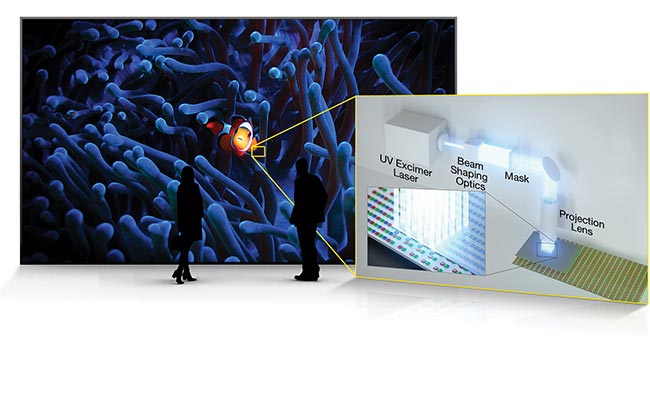
Bright, robust, and compatible with integrated sensing, micro-LEDs are the next generation of display technology. The biggest impediment to their commercial success is the complexity of their manufacture. Whatever future solutions arise, they will almost certainly rely on deep-ultraviolet (DUV) laser sources. Courtesy of Coherent.
Micro-LEDs carry the same properties as conventional LEDs, but they measure <50 μm, and even down to 3 μm. Each pixel can be individually controlled using RGB LED chips that can emit three different colors of light.
Because of the pixel pitch that their small size allows, micro-LEDs can offer resolutions of up to 10K pixel per inch (PPI) and deliver at least 100× the brightness of an OLED at a 50% lower rate of power. They consume only 10% of what conventional LCDs do.
“Micro-LED displays offer a raft of performance criteria that consumers want that is not possible in other existing display technologies,” Jiang said. “These include high brightness, high efficiency, self-emissivity, ultrahigh spatial resolution and contrast, ultralow power consumption, wide view angle and color gamut, fast operating speed, and environmental stability.”
The unique advantages and increasing popularity of micro-LEDs are influencing the development of the laser systems used in their fabrication. Manufacturing micro-LED displays can involve several laser processes to prepare, manipulate, and assemble the tiny pixels and the layers that make up the display. Specifically, lasers are used to anneal the silicon wafers, separate micro-LEDs from the glass carrier during transfer processes, and trim defective LEDs from the display. Optimizing laser sources to improve the throughput and cost-efficiency of all these processes is an ongoing challenge.
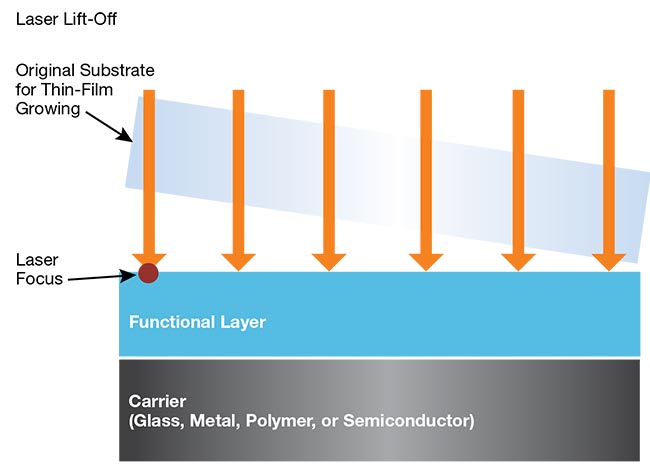
Fabrication of micro-LEDs relies on mass transfer processes such as laser lift-off (LLO), which involves the delicate and precise use of UV lasers to selectively separate the finished micro-LEDs from the sapphire growth wafer without causing damage to either. Courtesy of 3D-Micromac.
Excimers and solid-state lasers are the most commonly used sources. Excimers have higher pulse energies, which can reduce the heat-affected zone during materials processing applications. However, they are comparatively expensive, particularly due to the high cost and complexity of the beam delivery optics that they require. They are also difficult to maintain, use toxic gases, and require costly service.
Although incremental improvements to excimers are possible, some users question whether these sources will be as capable as solid-state sources in reducing micro-LED production costs.
Solid-state sources typically rely on either diode lasers to pump a crystal or doped fiber mediums to generate their NIR light. Nonlinear crystals can then triple their beam frequency to UV wavelengths. To make DUV sources more suitable for micro-LED production applications, suppliers are seeking to increase pulse energies and improve lifetimes. Increasing their repetition rate would also be useful, because it translates to higher average powers and, subsequently, higher productivity.
Smaller pixels, more complexity
One of the key impediments to broader adoption of micro-LED displays is the complexity of their manufacturing process. A major bottleneck in this process is the difficult mass transfer of millions of micro-LEDs from the semiconductor wafer on which they are grown to the display panel backplane, Lin said. “Innovative mass transfer processes, which would enable high throughput and yield, still need to be improved and optimized to increase the cost efficiency and reduce the final product price.”
Uwe Wagner, CEO of 3D-Micromac AG, agrees that despite the potential performance advantages of micro-LEDs, their production costs are helping to keep more established mini-LEDs, LEDs, and OLEDs competitive.
“Micro-LEDs offer the possibility of high-resolution and brilliant displays. The mere fact that each pixel is made up of three, four, or more LEDs leads to an extreme number of LEDs per display,” Wagner said. “But it is still not yet possible to reduce manufacturing costs to a marketable level.”
Laser transfer techniques
Unlike mini-LEDs, which are created via epitaxy techniques on a sapphire wafer, micro-LEDs must be separated from their growth substrate via a laser lift-off (LLO) process. Since the epitaxial layer of micro-LEDs is just a few micrometers thick, the transfer process requires a delicate and precise approach.
DUV lasers are the only option that can provide both the energy and the micron-level precision required to separate the epitaxial layers of gallium nitride (GaN) micro-LEDs from their growth substrate. In fact, the epitaxy wafer is bonded to a handle wafer that can be reused multiple times. “The GaN layer absorbs the applied laser energy in between the sapphire wafer and the micro-LED stack, which leads to evaporation of the nitride,” Wagner said. “Thus, the sapphire wafer is lifted off the micro-LED structures, and the so-called donor wafer remains.”
Although LLO techniques offer higher throughput than non-laser methods, their reliance on coherent beams makes them sensitive to a laser’s stability, beam homogeneity, pulse overlap, and pulse edge effects. This makes it critical that the energy of the laser beam be delivered uniformly.
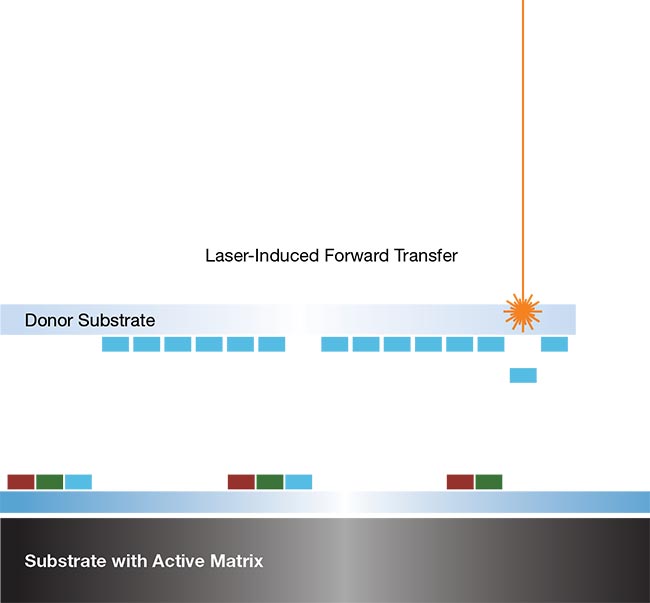
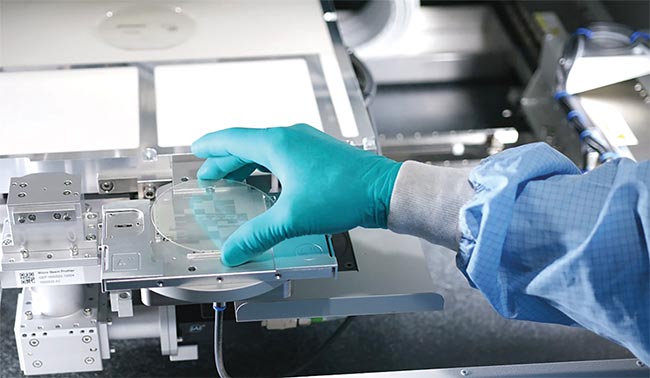
Laser-induced forward transfer (LIFT) is another mass-transfer method that provides high-throughput and cost-efficient transfer of micro-LED chips from the donor substrate to the display substrate (top).
A view into a 3D-Micromac laser-induced forward transfer (LIFT) process module (bottom). The system enables the transfer of hundreds of millions of micro-LEDs. Courtesy of 3D-Micromac.
Shin-Etsu Chemical, a materials research and development company with headquarters in Japan, uses the characteristics of 248-nm excimer lasers with beam shaping technology to help overcome these challenges.
“Micro-LED displays have more complexities compared with other displays due to extremely small chip size and the number of chips to process,” said Eiichiro Yamasaki, a manager in Shin-Etsu’s
Innovative Display Materials and Technologies department. “A 248-nm excimer laser achieves a uniform top hat-shaped line beam using a photomask that enables micro-LED chips to be irradiated with a uniform laser.”
“Micro-LED sizes are shrinking further, to as small as 3 to 5 µm, and that’s where laser transfer is the best and only option to meet the throughput and scale requirements for consumer display manufacturing.” Oliver Haupt, director of marketing, display vertical at Coherent Corp.
Unlike conventional LLO processes that use solid-state lasers, DUV excimer lasers can help eliminate the need for adhesives to protect chips from cracking and chipping. Today, Shin-Etsu’s process transfers micro-LED chips at high speeds and with an accuracy of 1 µm.
The processing time of the company’s system takes ~30 s to transfer >70 million micro-LED chips on an 8-in. wafer with an x/y chip pitch measuring 20 × 20 µm, Yamasaki said.
Although the conversion crystals in solid-state DUV lasers are subject to deterioration, recent developments at IPG Photonics have demonstrated significant improvements of DUV crystal lifetime. The result is higher stability of beam quality parameters.
The new technology allows users to operate the laser without crystal shifting, which removes concerns regarding the beam quality changing over time, said Alexei Markevitch, marketing development manager at IPG Photonics. “It makes laser operation simpler and reduces maintenance costs,” he said.
Excimer lasers operate in a single-pulse process with submicron absorption depth. In contrast, fiber or diode-pumped solid-state (DPSS) lasers generally raster scan their beam over the die with some expected pulse overlap to result. This may cause deeper total absorption depth.
Today’s DUV lasers can process micro-LEDs as small as 5 µm in size, which meets current application demands. The main focus going forward is to reduce material costs and increase repetition rates. Though material costs will decrease as micro-LED sizes diminish to single-digit micron level, Markevitch highlights that increasing repetition rate is almost always important.
“Higher repetition rates in excimer or solid-state DUV lasers increase average power,” he said. “And productivity always scales with average power. However, to be useful, higher repetition rates should be supported by beam delivery and positioning stages.”
After an LLO process releases GaN micro-LEDs from the sapphire wafer onto a temporary carrier, the LEDs must then be transferred en masse to the display. The scale of the micro-LEDs in question makes this a delicate and precise process that challenges even conventional LLO transfer methods, leading to interest in alternative approaches.
“Micro-LED sizes are shrinking further, to as small as 3 to 5 µm, and that’s where laser transfer is the best and only option to meet the throughput and scale requirements for consumer display manufacturing,” said Oliver Haupt, director of marketing, display vertical at Coherent Corp.
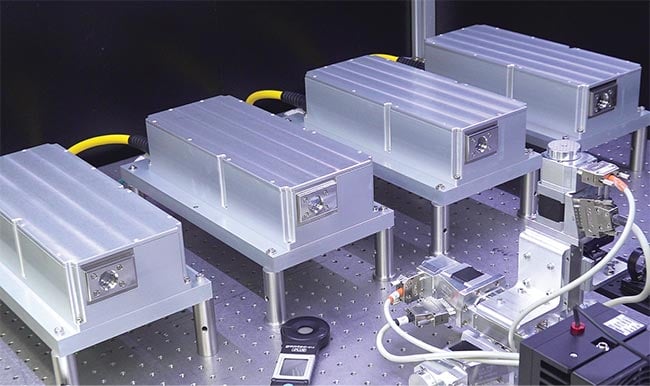
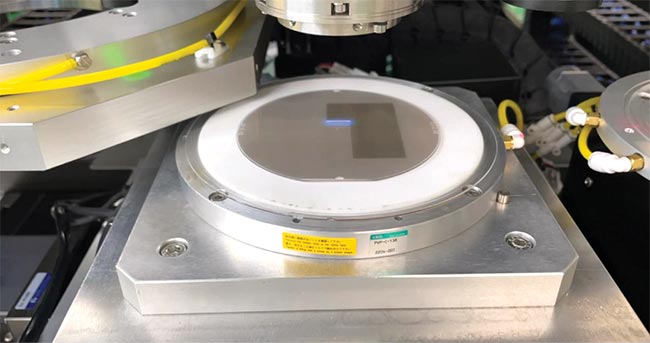
Deep-ultraviolet (DUV) lasers being tested in production (top). Although solid-state DUV lasers are subject to deterioration of their conversion crystals, recent developments at IPG Photonics have demonstrated significant improvements of crystal lifetime. The result is higher stability of beam quality parameters. Courtesy of IPG Photonics.
Laser lift-off (LLO) techniques are sensitive to the laser’s stability, beam homogeneity, pulse overlap, and pulse edge effects, which requires uniform delivery of beam energy (bottom). Courtesy of Shin-Etsu Chemical Co. Ltd.
This process, more specifically known as laser-induced forward transfer (LIFT), can place millions of individual micro-LEDs on a display with micron-level precision. And with markets demanding the transfer of >100 million dies per hour while maintaining placement accuracy better than 1.5 µm, DUV excimer lasers offer the optimal energy stability for industry-required throughput.
“Excimer lasers have been proven for display applications with decades of best-in-class performance,” Haupt said. “Their high pulse energy in particular enables the highest throughput and real industrial manufacturing.”
Repair and refurbishment
Lasers also find use in repair and refurbishment processes to correct defects or damage in micro-LED displays. According to Weiyi Gu, vice president of Focuslight’s Pan-Semiconductor Solutions Business Unit, the mass transfer process must maintain LED placement accuracy within ±0.5 µm for each chip to ensure yields. But even with a yield rate as high as 99.999%, a 4K TV will still have ~260 dead pixels that require repair.
“This is where the laser’s high precision and directivity play a significant role,” Gu said.
Typically, chip repair processes involve inspection, detection, laser removal, and laser soldering steps. In addition to its role during mass-transfer production, LLO and LIFT technology can also be applied to replace malfunctioning micro-LEDs with functional ones.
Initially in this process, high-precision optical detection equipment identifies and locates dead spots on the chips. Then, high-peak energy laser beams remove these dead spots before single chips undergo transfer to the empty spot where a laser solders them in place.
Though lasers are critical for both transfer and repair of micro-LEDs, the two tasks prioritize different performance parameters from the sources used. “A full-wafer LLO process requires high pulse energy to achieve the throughput needed for full-wafer processing. By increasing the pulse energy, one increases the irradiation areas which, in turn, enables higher throughput,” said 3D-Micromac’s Wagner. “In contrast, trimming requires laser exposure onto a single micro-LED, and any instability in the timing or positioning can cause the laser spot to miss the micro-LED.”
Refractive optical elements shape laser output to large or precisely small beam spots in square, linear, and rectangular geometries.
“The minimum beam length can reach as short as 50 μm, while the energy output in the length and width direction can still be top hat with a uniformity of more than 97%, making it an optimal solution to the repair of micro-LED chips in different sizes,” Gu said.
Looking to the future
Because micro-LED displays are in the early stage of their product life cycle, manufacturing standards are not yet fixed. It is almost certain that, in the future, mass production operations of these displays will place requirements on DUV sources that are not currently met. There will be steady pressure for lasers to deliver higher repetition rates and better beam uniformity to improve throughput and, thus, the cost of these displays.
Meanwhile, developments in DUV laser technology itself will raise the bar for these sources. Current solid-state DUV lasers for micro-LED fabrication deliver output power levels of 10 W. As their output power increases, these lasers could become the laser of choice for display manufacturing. Apart from advancements in laser sources, experts stress that beam delivery systems, optics, and material compatibility are just as important to the success of micro-LED displays.
“Just developing the DUV source cannot achieve mass production of micro-LED displays,” said Yamasaki. “It is important to develop both material technology and equipment technology, and the compatibility between material and equipment is further important.”
Hopes are high for the future of DUV sources and the crucial role they play in manufacturing micro-LED displays. The symbiotic relationship between the two technologies is set to continue adding to the development of both.
“I personally have a strong belief that the micro-LED display market will eventually achieve significant market success,” Wagner said. “This will result in increased demand, which will in turn accelerate future development and price-performance optimization of DUV sources.”
The attention of display-makers worldwide is increasingly moving to micro-LED technology, with almost all suppliers demonstrating the first prototypes. With the growth of micro-LED adoption, scaling of production equipment is key.
“Our industrial UV lasers and optical systems enable 24/7 production of high-resolution OLED displays today and we are engaged for the next technology,” said Coherent’s Haupt. “We have demonstrated that for OLED displays and will do it again for micro-LEDs.”